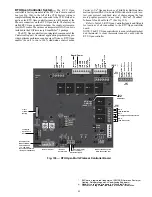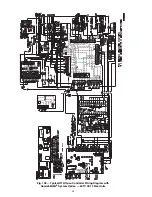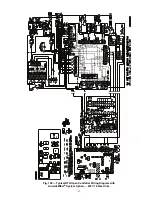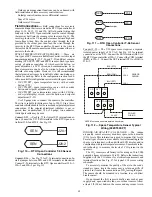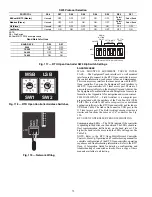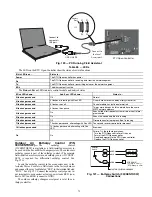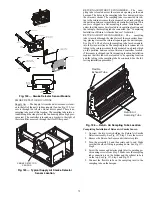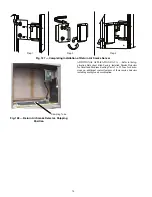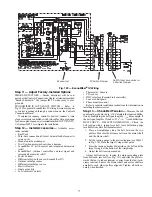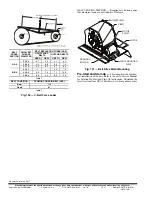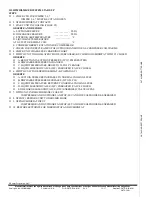
74
DIFFERENTIAL ENTHALPY CONTROL — Differential
enthalpy control is provided by sensing and comparing the out-
side air and return air enthalpy conditions. Install the outdoor
air enthalpy control as described above. Add and install a re-
turn air enthalpy sensor.
RETURN AIR ENTHALPY SENSOR — Mount the return-
air enthalpy sensor (33CSENTSEN) in the return-air section of
the economizer. The return air sensor is wired to the enthalpy
controller (33CSENTHSW). See Fig. 122.
To wire the return air enthalpy sensor, perform the following:
1. Use a 2-conductor, 18 or 20 AWG, twisted pair cable to
connect the return air enthalpy sensor to the enthalpy con-
troller.
2. Connect the field-supplied RED wire to (+) spade con-
nector on the return air enthalpy sensor and the (+) termi-
nal on the enthalpy controller. Connect the BLK wire to
(–) spade connector on the return air enthalpy sensor and
the (–) terminal on the enthalpy controller.
Fig. 122 — Outside and Return Air Enthalpy
Sensor Wiring
Smoke Detectors —
Smoke detectors are available as
factory-installed options on 50TC units. Smoke detectors may
be specified for Supply Air only or for Return Air without or
with economizer or in combination of Supply Air and Return
Air. Return Air smoke detectors are arranged for vertical return
configurations only. All components necessary for operation
are factory-provided and mounted. The unit is factory-config-
ured for immediate smoke detector shutdown operation; addi-
tional wiring or modifications to unit terminal board may be
necessary to complete the unit and smoke detector configura-
tion to meet project requirements.
Units equipped with factory-optional Return Air smoke de-
tectors require a relocation of the sensor module at unit installa-
tion. See “Completing Installation of Return Air Smoke Sen-
sor:” on page 75 for details.
SYSTEM — The smoke detector system consists of a four-
wire controller and one or two sensors. Its primary function is
to shut down the rooftop unit in order to prevent smoke from
circulating throughout the building. It is not to be used as a life
saving device.
CONTROLLER — The controller (see Fig. 123) includes a
controller housing, a printed circuit board, and a clear plastic
cover. The controller can be connected to one or two compati-
ble duct smoke sensors. The clear plastic cover is secured to the
housing with a single captive screw for easy access to the wir-
ing terminals. The controller has three LEDs (for Power, Trou-
ble and Alarm) and a manual test/reset button, all located on
the cover face.
SENSOR MODULE — The sensor module (see Fig. 124) in-
cludes a plastic housing, a printed circuit board, a clear plastic
cover, a sampling tube inlet and an exhaust tube. The sampling
tube (when used) and exhaust tube are attached during installa-
tion. The sampling tube varies in length depending on the size
of the rooftop unit. The clear plastic cover permits visual in-
spections without having to disassemble the sensor. The cover
attaches to the sensor housing using four captive screws and
forms an airtight chamber around the sensing electronics. Each
sensor includes a harness with an RJ45 terminal for connecting
to the controller. Each sensor has four LEDs (for Power, Trou-
ble, Alarm and Dirty) and a manual test/reset button (on the
left-side of the housing).
Air is introduced to the duct smoke detector sensor’s sens-
ing chamber through a sampling tube that extends into the
HVAC duct and is directed back into the ventilation system
through a (shorter) exhaust tube. The difference in air pressure
between the two tubes pulls the sampled air through the sens-
ing chamber. When a sufficient amount of smoke is detected in
the sensing chamber, the sensor signals an alarm state and the
controller automatically takes the appropriate action to shut
down fans and blowers, change over air handling systems, no-
tify the fire alarm control panel, etc.
The sensor uses a process called differential sensing to pre-
vent gradual environmental changes from triggering false
alarms. A rapid change in environmental conditions, such as
smoke from a fire, causes the sensor to signal an alarm state but
dust and debris accumulated over time does not.
For installations using two sensors, the duct smoke detector
does not differentiate which sensor signals an alarm or trouble
condition.
Fig. 123 — Controller Assembly
GRA
BLK
RED
–
4-20
MAIN
+
VDC
OUT
–
4-20 MAIN
OUT
+
24-
3
6
VDC IN
LOW
GND
24V
7
PL6-1 (24-V)
PL6-4 (COM)
OUT
S
IDE AIR
ENTHALPY
S
WITCH
RETURN AIR
ENTHALPY
S
EN
S
OR
CTB ECON
(P
’
LINK: to J4-2) or
(RTU Open: to J2-6)
Duct smoke sensor
controller
Fastener
(2X)
Controller cover
Conduit nuts
(supplied by installer)
Conduit support plate
Cover gasket
(ordering option)
Conduit couplings
(supplied by installer)
Terminal block cover
Controller housing
and electronics
Alarm
Power
Test/reset
switch
Trouble
Summary of Contents for Carrier WeatherMaker 50TC A08 Series
Page 4: ...4 Fig 2 Unit Dimensional Drawing Size 08 09 12 Units...
Page 5: ...5 Fig 2 Unit Dimensional Drawing Size 08 09 12 Units cont...
Page 6: ...6 Fig 3 Unit Dimensional Drawing Size 14 Unit...
Page 7: ...7 Fig 3 Unit Dimensional Drawing Size 14 Unit cont...
Page 9: ...9 Fig 4 Unit Dimensional Drawing Size 16 Unit cont...
Page 13: ...13 Fig 8 Roof Curb Details Size 16 Unit...
Page 50: ...50 Fig 73 50TC 16 Control Box Component PremierLink Locations...
Page 51: ...51 Fig 74 Typical PremierLink Control Wiring Diagram...
Page 52: ...52 Fig 75 Typical PremierLink Control Wiring Diagram with Humidi MiZer System Option...
Page 64: ...64 Fig 106 Typical RTU Open Controller Wiring Diagram 50TC 08 14 Size Units...
Page 65: ...65 Fig 107 Typical RTU Open Controller Wiring Diagram 50TC 16 Size Unit...




